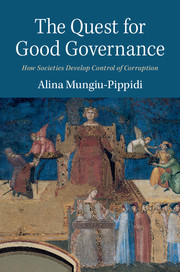Book contents
- Frontmatter
- Colophon
- Contents
- List of figures
- List of tables
- List of abbreviations
- Acknowledgments
- 1 Understanding control of corruption
- 2 Diagnosis and measurement
- 3 The road to Denmark: historical paths to corruption control
- 4 Structure and agency: determining control of corruption
- 5 Understanding contemporary achievers
- 6 Domestic collective action capacity
- 7 International agency and its anticorruption impact
- 8 From critical mess to critical mass: some tentative policy conclusions
- Appendix 1 Explaining bribery
- Appendix 2 List of variables and sources
- Appendix 3 Brief description of databases and surveys used
- Appendix 4 Impact of anticorruption interventions on control of corruption: bivariate regressions
- Appendix 5 HDI differentials from Figure 4.1
- Appendix 6 Classification of countries by governance orders
- References
- Index
4 - Structure and agency: determining control of corruption
Published online by Cambridge University Press: 05 September 2015
- Frontmatter
- Colophon
- Contents
- List of figures
- List of tables
- List of abbreviations
- Acknowledgments
- 1 Understanding control of corruption
- 2 Diagnosis and measurement
- 3 The road to Denmark: historical paths to corruption control
- 4 Structure and agency: determining control of corruption
- 5 Understanding contemporary achievers
- 6 Domestic collective action capacity
- 7 International agency and its anticorruption impact
- 8 From critical mess to critical mass: some tentative policy conclusions
- Appendix 1 Explaining bribery
- Appendix 2 List of variables and sources
- Appendix 3 Brief description of databases and surveys used
- Appendix 4 Impact of anticorruption interventions on control of corruption: bivariate regressions
- Appendix 5 HDI differentials from Figure 4.1
- Appendix 6 Classification of countries by governance orders
- References
- Index
Summary
It is no easy task to find data and build explanatory models to disentangle a causal mechanism as complex as control of corruption, and the attempt must be approached with considerable caution. Still, the role of constitutional monarchy, island, human agency, or the state-society nexus can be statistically tested to complement our historical findings. The brief historical overview of how control of corruption came into being produced several findings that warrant further discussion, some of which can be tested. To further our understanding of how control of corruption actually functions or does not function, this chapter will resort to a large-N comparison method, wherein econometric methods will be used to test determinants of control of corruption across as many countries as possible (data allowing). Although an impressive amount of literature has already been produced to explain corruption by econometric means, discussing causality in governance is in general problematic due to the absence of time series data, dependent variables based on subjective data, reverse causality problems, and insufficient theorization (Fukuyama 2013; Rothstein and Teorell 2011; Seldadyo and De Haan 2006; Treisman 2007). The associations discussed in this chapter seek to expose in which contexts control of corruption is more likely to develop, addressing the reverse causality problem by reference to historical circumstances or policy context rather than statistical means. Where our theory and data sources are incomplete, application of advanced statistics alone is unlikely to produce more clarification, though theoretical statements of this work are clear and testable to a large extent. The most important problem remains the absence of a specific dependent variable to measure governance across countries, available for a longer interval of time and sensitive to change. In its absence, most causal models at the national level are based on expert scores, either one-source and nontransparent (like the most quoted work by Paulo Mauro (1995), based on Business Index, a risk score) or aggregated from various sources with different degrees of transparency (Corruption Perception Index, Control of Corruption). Another strategy explains corruption at the national level by creating a country average from individual survey responses, as shown in Chapter 1.
- Type
- Chapter
- Information
- The Quest for Good GovernanceHow Societies Develop Control of Corruption, pp. 83 - 129Publisher: Cambridge University PressPrint publication year: 2015



